Rowanberries or Mountain ash berries are an edible berry from a tree most people don't think of as food. If you're Scandinavian like me, cooking with these deliciously bitter fruit is in your blood. Oh, and you can use them to cast magic spells, or so the legends go.

What are Rowanberries?
Rowan berries are the fruit of a number of different trees in the Genus Sorbus. The fruit appear as clusters of red or bright orange berries in the late summer and fall. They're related to apples and roses, and distantly, to Aronia.
The best variety I've cooked with is Sorbus americana, but there's others like Sorbus aucuparia that are often sold as ornamental trees for landscaping. It can be difficult to separate between species as the trees will hybridize and cross-pollinate.
Fruit
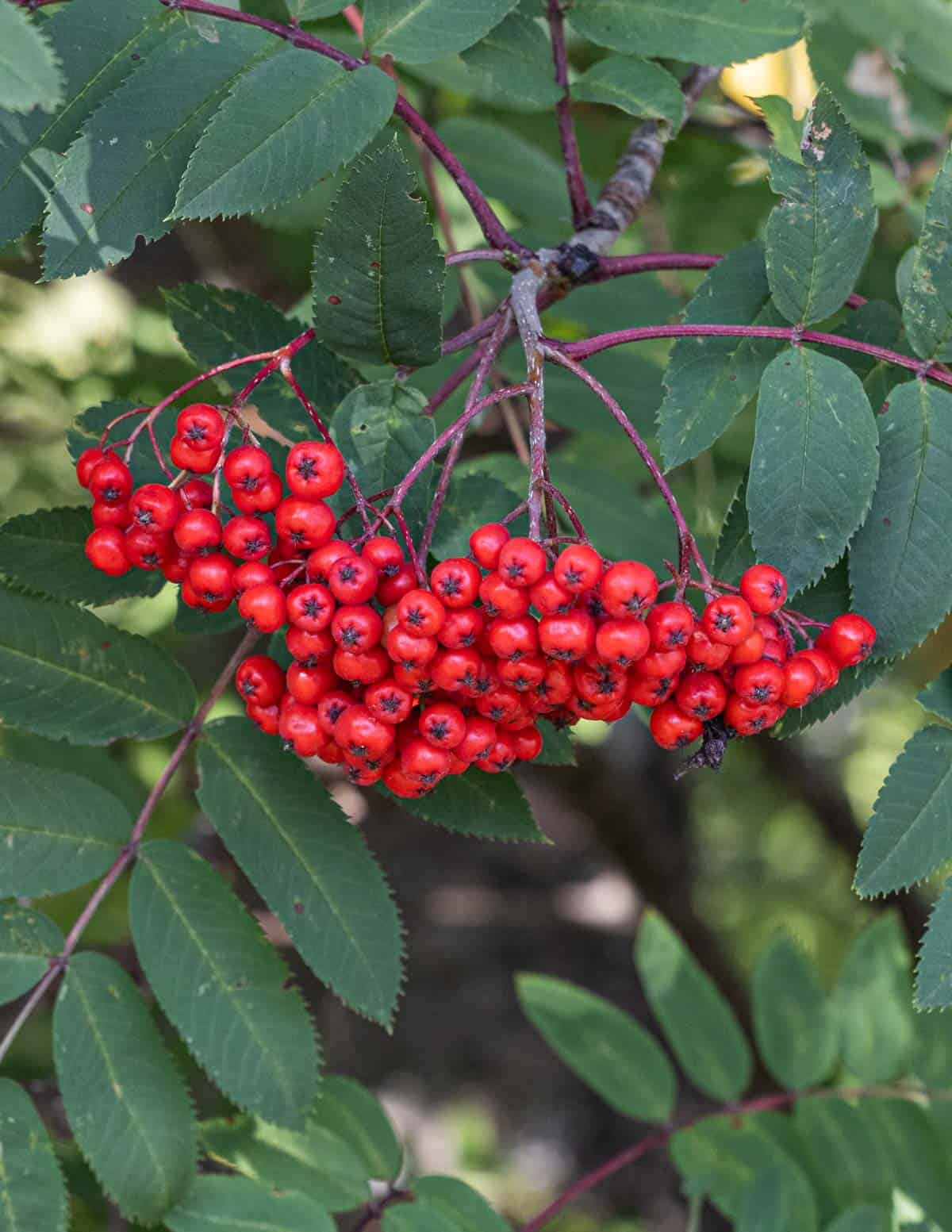

Leaves and Bark
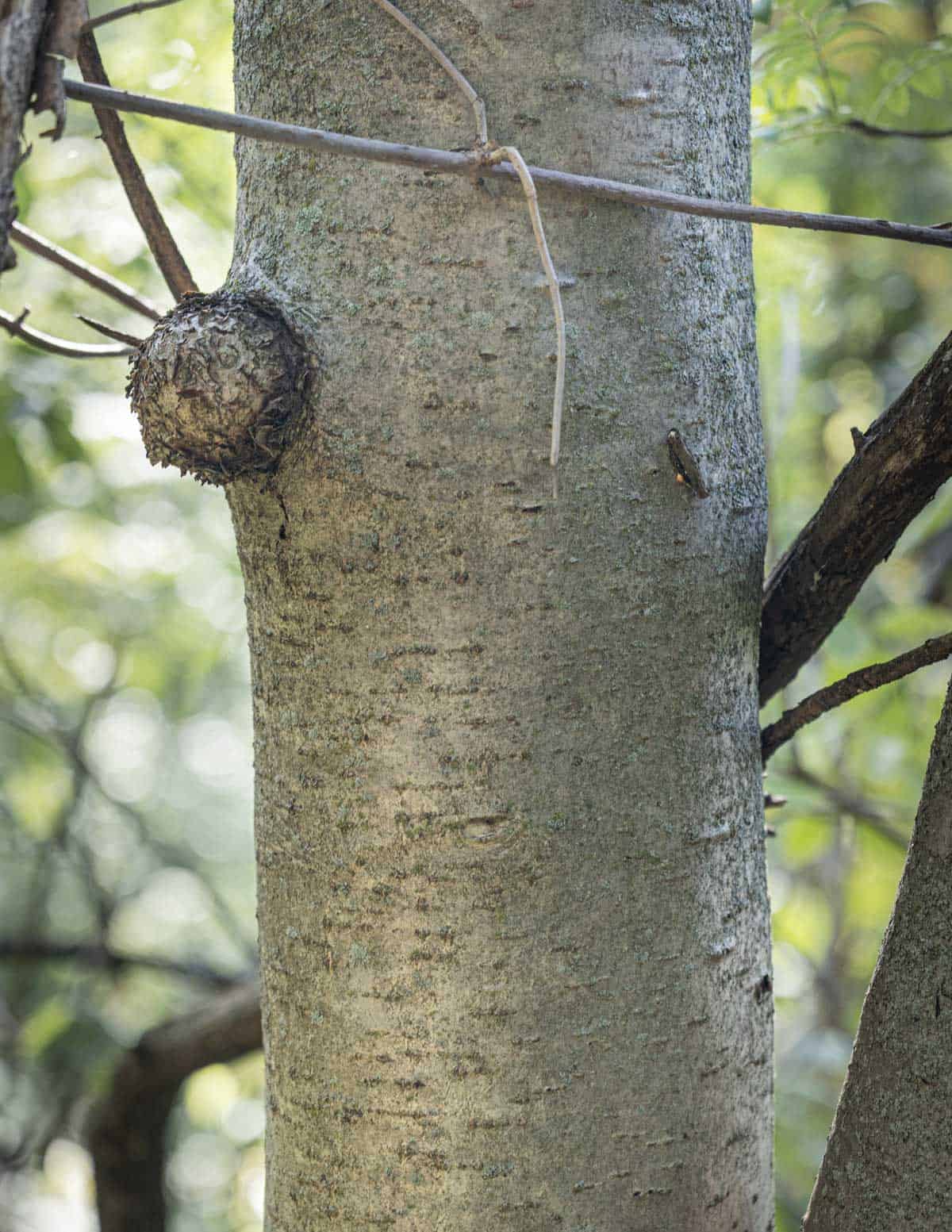

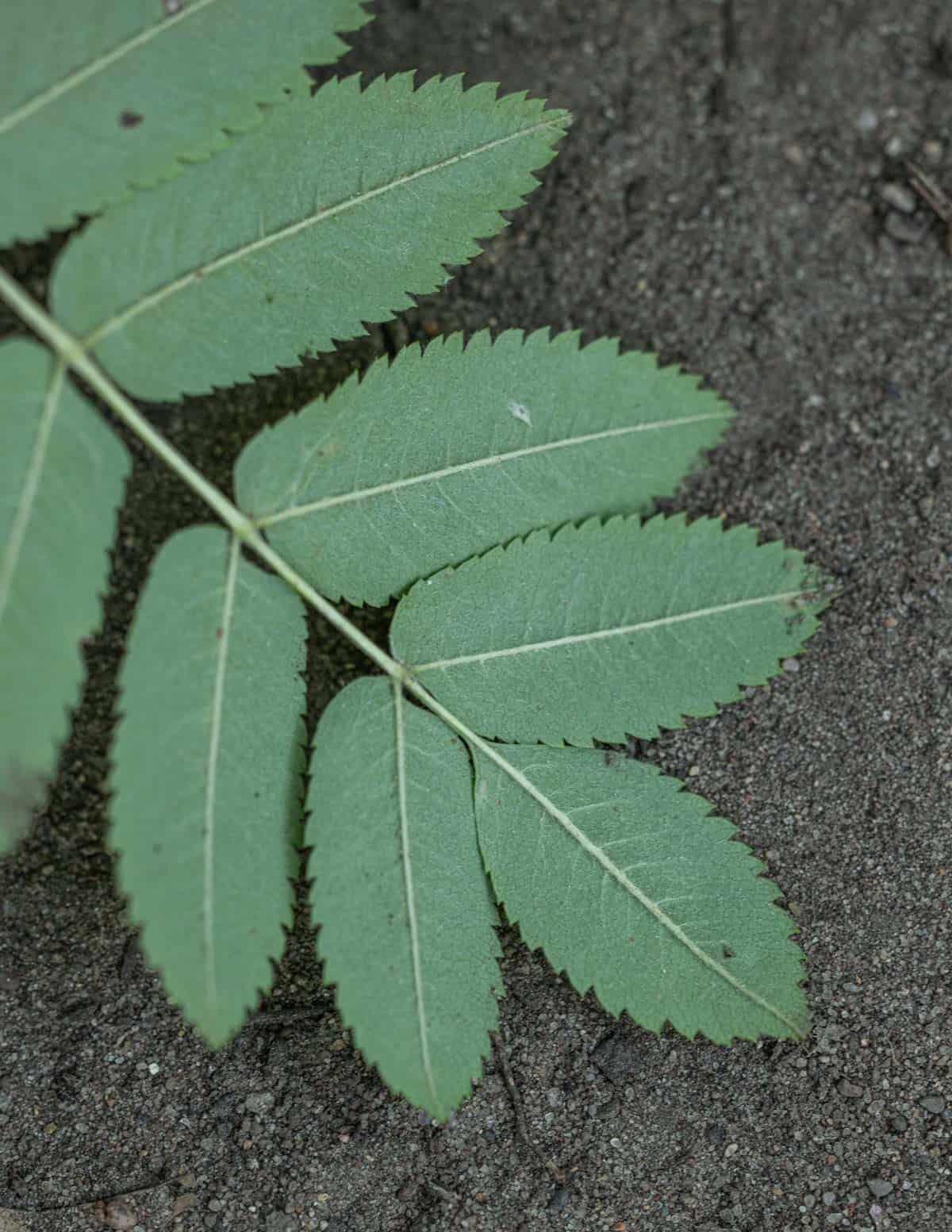
If you dig around a little online, you'll see glimpses of their history, especially in the old Celtic and Anglo Saxon traditions of Europe. See a fun page with archeological finds used to plan viking period themed menus including rowan berries here.
I'd never heard of the berries, or the mountain-ash trees they grow from until my foraging friend mentioned them and said that people made them into jams, jellies, and pickles.
The tree stuck out like a sore thumb: a medium sized tree, about 40 ft or so, filled with so many berries that the branches were bowing under their weight. If the Garden of Eden were a place, it would have plants that produce fruit like the mountain ash tree.
Can you Eat Rowan Berries?
Yes, they're a traditional food. The berries are edible raw in small amounts or cooked, but most will find them unpalatable raw. It's also important to note that in their raw state, the fruit contain cyanogenic glycosides, which is common in other related plants in the Prunus / Rose family (Rosaceae).
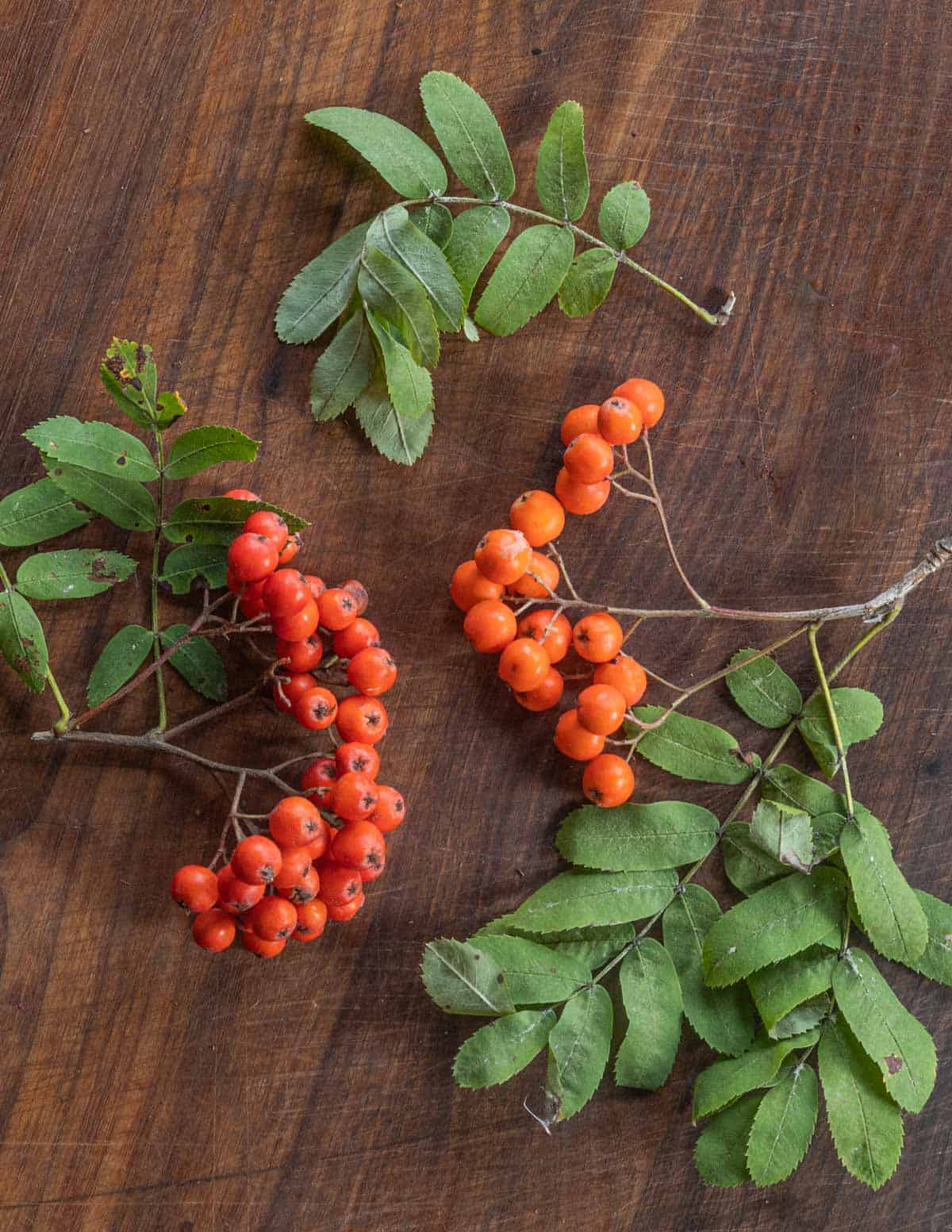
These glycosides can have an almond flavor and is the reason almond extract is made from the same compound in bitter almonds. Cooking makes the fruit safe and denatures the glycosides. See more in my post Cherry Pits: A Traditional Almond Seasoning.
Recently someone from Norway sent me a video of people eating rowan buds for their almond flavor. While true, this is a novelty as the glycosides need to be cooked to be safe.
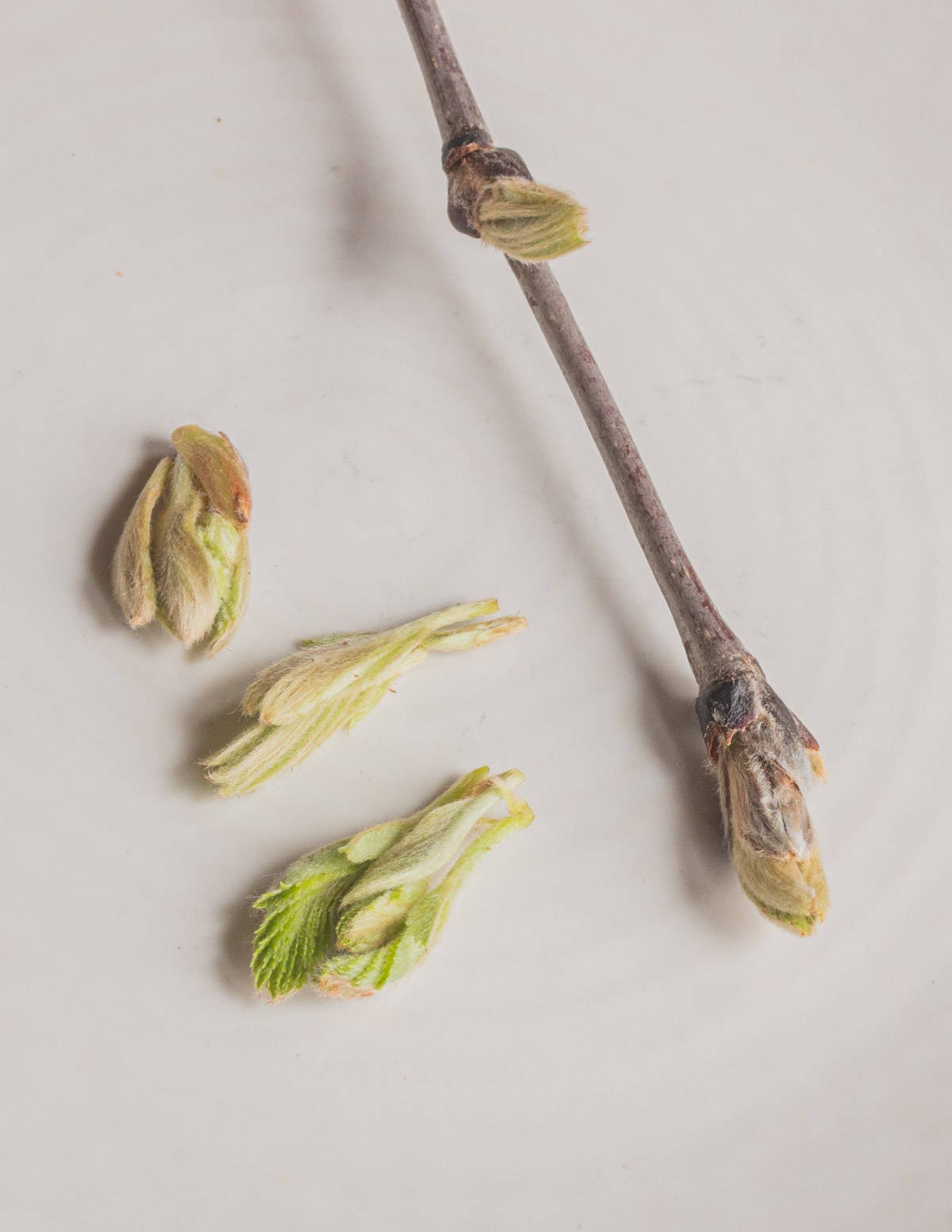
After your first taste, the word "fruit" might not seem as correct to describe them as you'd think, since rowan berries eaten fresh are super astringent/bitter. I'll be honest, they didn't seem like something I would want to eat, at first. The challenge to create with them was a lot of fun though.
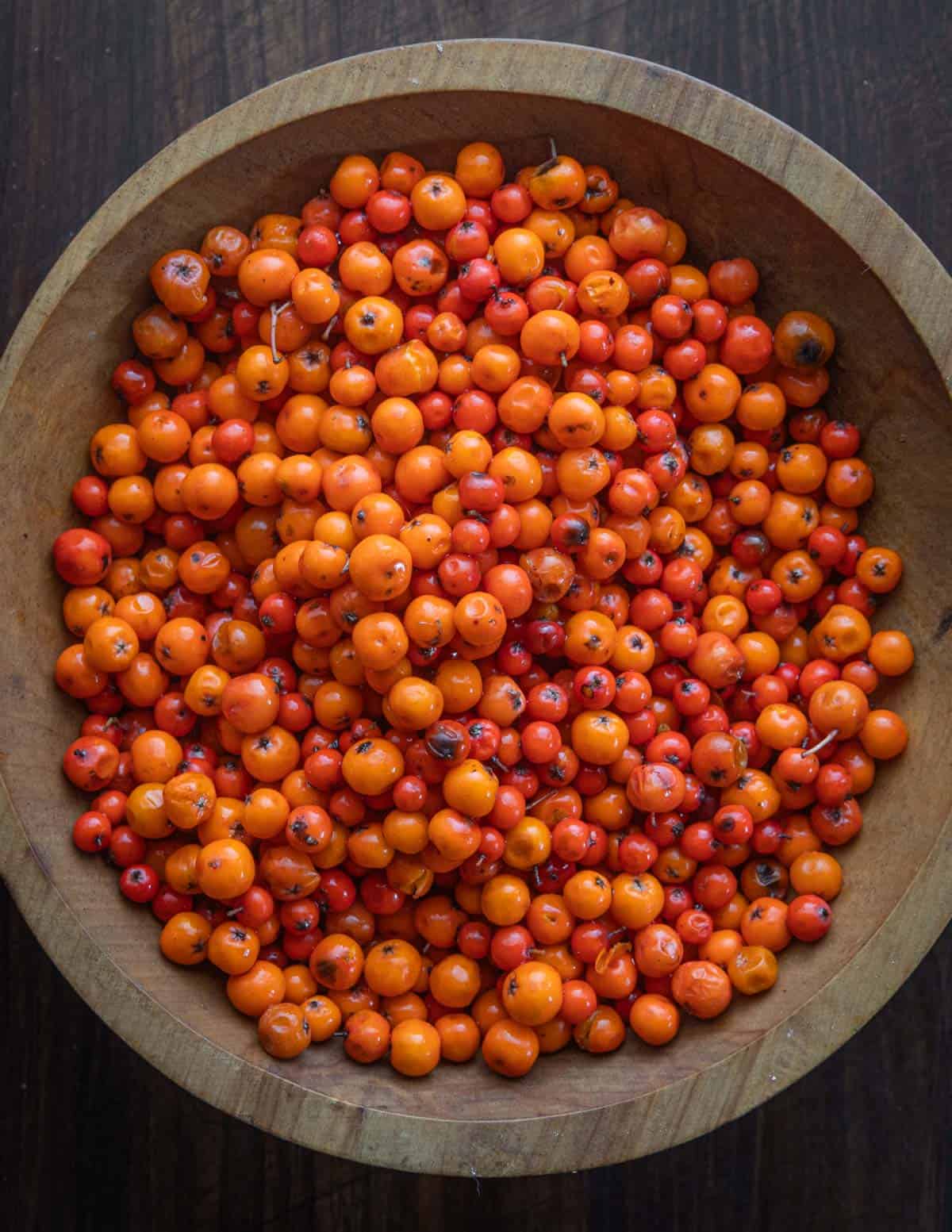
What got me even more excited was as I read through one of my favorite books, Faviken, I noticed the chef uses rowan berries in plenty of things.
Faviken was one of the most cutting edge restaurants in the world, and the terroir around their restaurant (located in Sweden) is similar to Minnesota, where I live in that it is a cold weather climate.

What Can You Do with Rowan berries?
Remove the berries from the stem and rinse them clean. After that they can be refrigerated for 2 months, or frozen without a loss in quality.
I tried a number of different preparations: Jelly, liquors, pickled, dried, frozen to concentrate their sweetness and then cooked (unsuccessful), cooked from raw, preserved in syrup, made into jam, and a funky technique of fermenting them in a water filled mason jar in the fridge like the Scandinavians do with lingon berries.
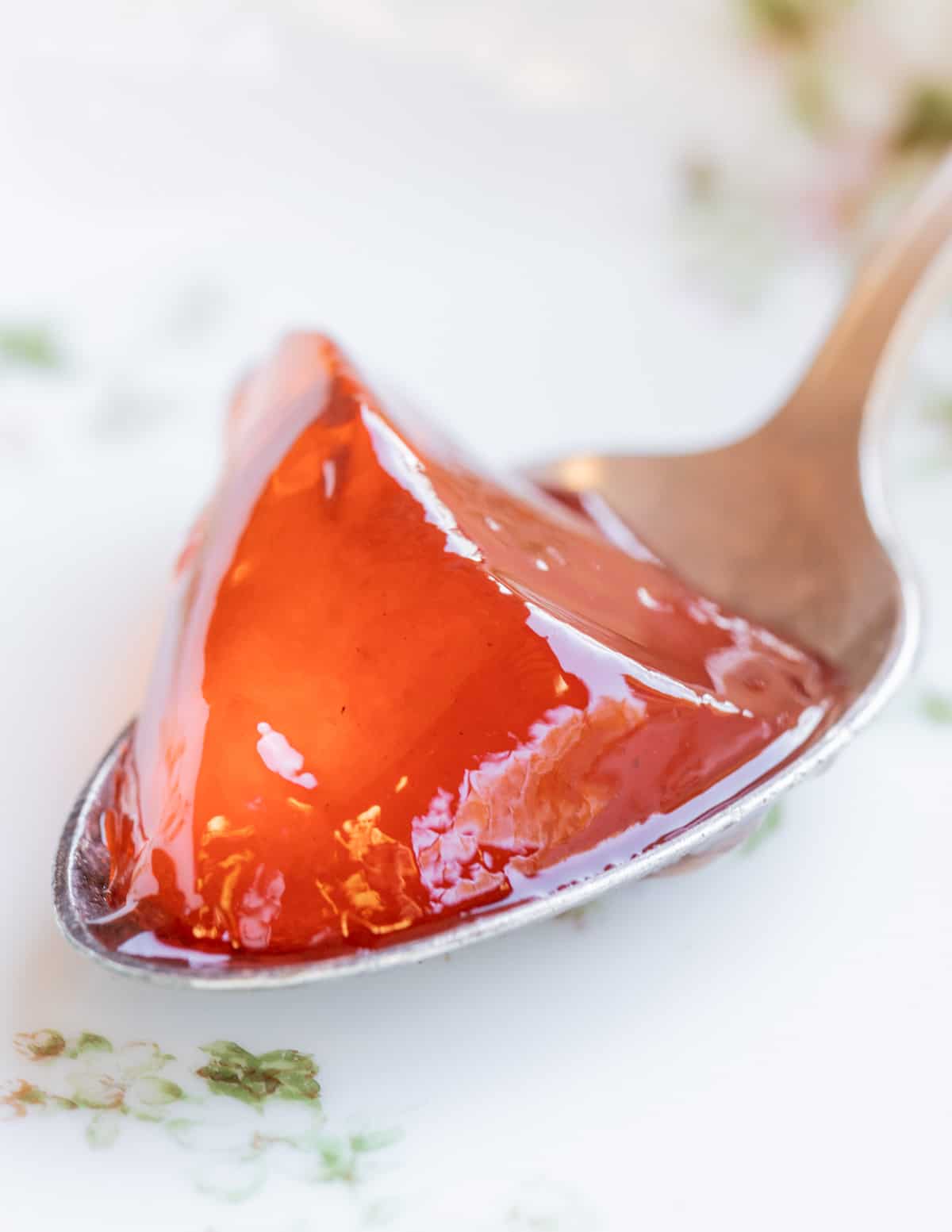
I also made sure to save berries picked before and after the frost to taste side by side, since plenty of people say they should be picked after the frost, since it makes them sweeter.
Here's my thoughts the berries are always going to be a bit bitter, but it isn't insurmountable. At first, I didn't think there would be any merit to the old wives tale about eating these after a frost, but there is.

Pick Rowanberries After a Frost
So, you went out and tasted a rowanberry, then thought about typing a message to me that I'm full of it, or maybe you've tasted them before and are wondering what the heck kind of palate this chef has. It's all about the cold weather with rowans, more so than any fruit I've tasted.
You can't just go out after the first frost though, because they'll still be horribly bitter. Like parsnips, you'll need repeated hard frosts to calm the flavor. But, I couldn't understand how I could even pick the berries after it got cold, since the cedar wax wings seemed to strip all of the rowan trees overnight.
The secret was that I was trying to hunt the berries in the wrong habitat. I was hunting the berries around the Twin Cities metro area, where our native mountain ash is relegated to small patches. My mistake was not understanding rowanberries are a creature of the cold north.
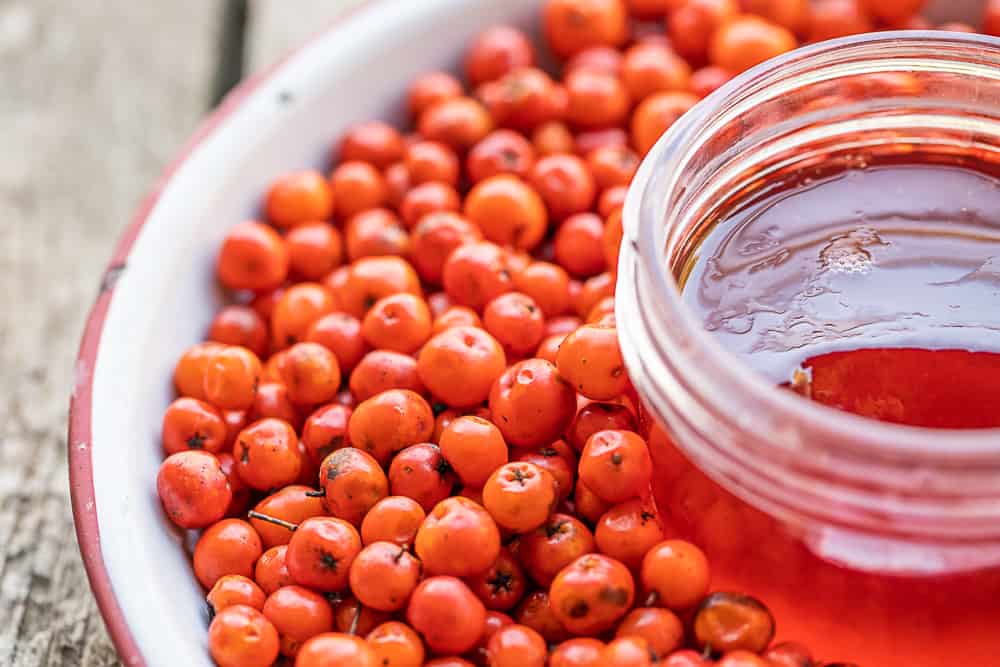
The berries will tolerate living in the central portion of the state, but their population thrives in the northern Minnesota forests dominated by pine, birch, and acidic, sandy soil. Even deep into October, the Rowanberries seemed to be everywhere on the trees on the Minnesota North Shore.
I had never seen so many in my life, and to my surprise, I could eat them straight off the tree without puckering as if I'd eaten something horrible. Tasting the berries after they'd been exposed for an extended period of time to the cold made them a completely different fruit.
Different Species, Different Flavors
There are different species of mountain ash, and they may taste slightly different. One tree I pick from has very small berries that I can eat straight from the tree and barely taste any bitter, some are incredibly bitter raw.
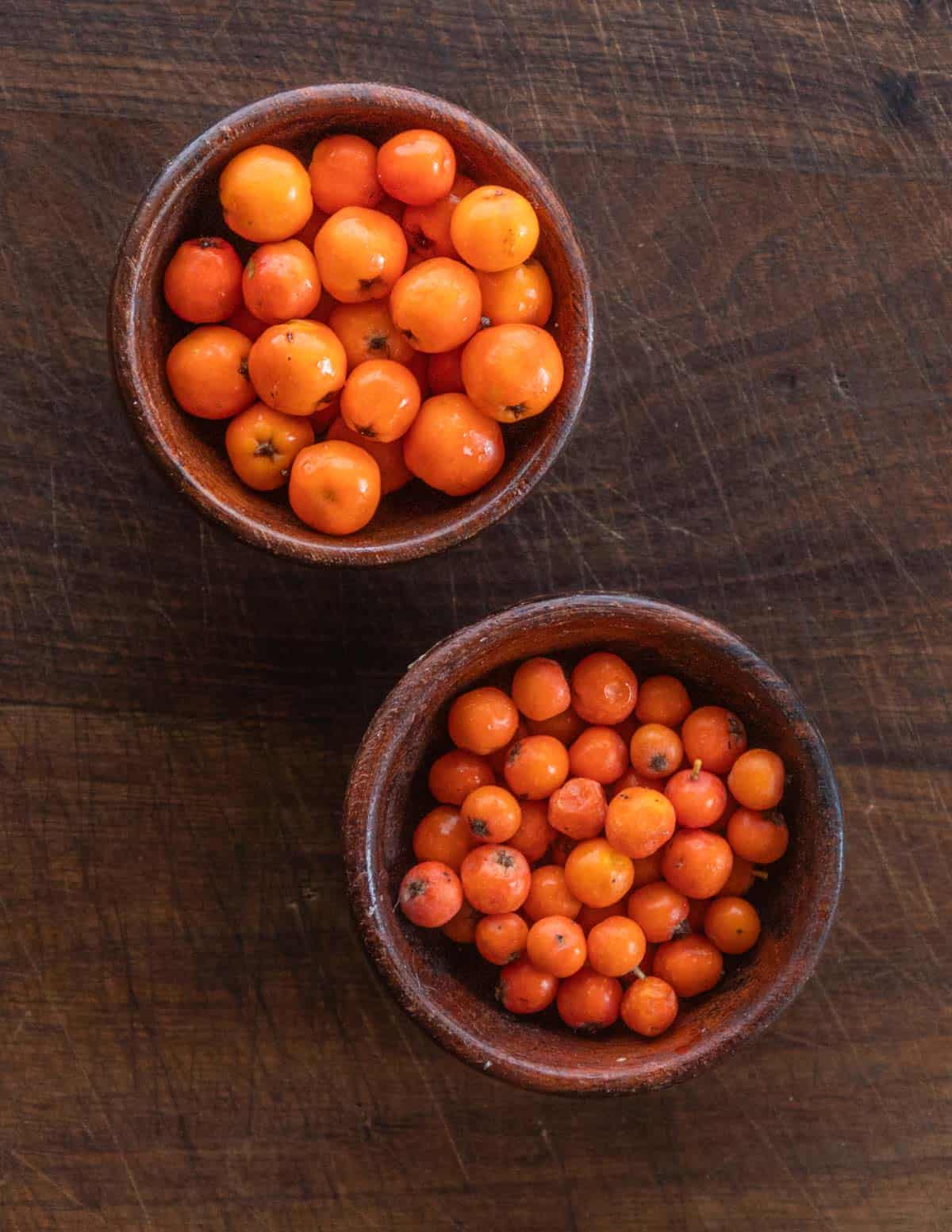
I'm a chef, not a botanist, so I can't speak to all the different types and hybrids, but don't be discouraged. From my experience, our native species (S. americana) produces bigger, better tasting berries more dependably than ornamental varieties. That said, all varieties I've had are interchangeable in the kitchen.
I've read about them being compared to cranberries, and if you have a little patience you might agree, but they take some finesse to get there.

Pairing their flavor with things is easy though, just imagine cranberry, which means they go well with, but shouldn't be limited to partners like:
- Honey
- Sugar
- Herbs like thyme, tarragon, bay, chervil, spearmint, basil, peppermint
- Ginger
- Apples, pears, orange juice and zest,
- Warm spices like clove, nutmeg, cinnamon, and allspice, in moderation
How do they taste? Rowan berries, like I mentioned, are bitter at first, but also have a bright berry-ness to them comparable to orange and grapefruit peel, but it's hidden behind a strong flavor many people will find unpalatable. However you treat them, they'll retain a bit of the bitter edge.

Before you spout off an email at me, know that the flavor mellow more after a couple months. Jelly is an exception, and is fine immediately after it sets.
Recipes
Here's a few basic ways to preserve them I like and links to other recipes I've created for them. The first thing you should do is make the classic jelly and Schnapps. The berries freeze well and cooked directly from the freezer, too.
- Classic Rowanberry Jelly
- Rowanberries in syrup
- Rowanberry Schnapps
- Rowanberry-Apple Jam
- Rowan Vinegar

How to Harvest and Process Rowan Berries for Cooking
Equipment
- 1 Fruit hook I use an unraveled coat hanger to access tall branches.
Ingredients
- 4 lb Fresh rowan berries removed from their stems (This is enough fruit to make jelly and vinegar)
Instructions
- Harvest the whole clusters of fruit in the fall, preferably after a frost.
- Look over the berries and remove any that look old, dark, or fizzy (fermented).
- Wash the rowan berries to remove any debris.
- Put the fruit in a container and refrigerate. They'll last for two months fresh. Use them to make rowan jelly, schnapps or vinegar first.
Freezing
- For long term storage the fruit should be frozen. Freeze the berries on a baking sheet lined with parchment, then transfer to a zip top bag or other container and freeze.
Drying
- Some people like to use the berries in tea. If you'd like to try that, here's a simple method for drying the berries
- To dry the berries, then place in a dehydrator and dry at 135-150 degrees for 24 hours. Place the berries in an airtight container, preferably with little excess air (like a plastic freezer bag) and refrigerate. Use dried berries to make brewed tea mixed with orange peel and warm spices.



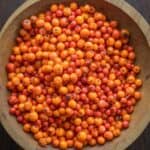
Ieva
I like to make a rowanberries salt. It's tastes like a salt and pepper, and have a nice orange colour. Once maked as a Christmas gift and next year my relatives asked for the same.
Nancy Devlin
In Scotland nearly every home has a rowan tree as they are considered a good luck tree for the home. I have only in the last couple of years started using the berries and they do make a good replacement for cranberry sauce . I also make a jam and put spices through it which is lovely at Christmas time.
John
I believe that sorbate/sorbicc acid was discovered in this genus. You find it listed often as an ingredient for preservation of food.
I find that berries appear ripe in early August, here in zone 5 Allegheny mountains. Although we have abundant towhees and other birds of eclectic palate, they don’t feed noticeably. But the berries are all dried out by first frost ~ October 15; flavor is then gone.
For ripening of pears they can be refrigerated 2 - 6 weeks then brought to room temperature to ripen. I plan to give this a try.
Daryl
Hi, I was wondering if I froze them it would act the same as going through a frost? I'm going to try it, but just wondering your thoughts. They're ripe here (PNW) and there's no way they're going to stay ripe til the first frost! It's cool that they're like rosehips in that regard - I have a rowan tree next to a bunch of wild rose bushes on my property!
Alan Bergo
No. I need to add another note here that reads something like "multiple hard frosts". If your berries won't stand up long enough for that, or if the birds will get them, you'll need to find another tree. There is no comparison to the change (improvement of flavor) after a few cold snaps. I've found I can't even get them from trees near me around St. Paul, I have to drive up 3 hours north where the trees are widespread and the birds can fill up on other things (I assume).
Daryl
Thanks. I won't try it! I realize when I asked, I didn't think about the fact that there are biological changes that happens to the tree when there are freezes, not just that the berries get cold.
Lyd
Would be wise to note that they are highly poisonous raw and need to be cooked to deactivate the toxin!
Alan Bergo
A single taste raw is a very strong deterrent.
Rawan
My name is the name of these berries! I want to try them so badly but it's impossible to get them from where I live. One day in the future I'll go back to Europe to try these barries!
Peter J. Markunas
I grew up with my grandmother from Lithuanian who was a well known herbologist when she arrived. It was the turn of the last century, and she would always have a few rowan/mountain ash trees for the healing effect of the berries, high in ascorbic acid. Migrating birds would flock to the trees, guzzle them down and sit on clothes lines and trees and drop their acidic bombs on the clothes below and cars.
I planted mountain ash where I live, Cape Cod, MA., and at the time there were plenty of mountain ash trees to be found. Then we got hit with a blight, that killed the berries every year, before they got ripe, and eventually killed the tree.
I'm hoping someone out there has some dried, or fresh berries that I could buy. I'll pay, and pay for one or two day shipment if fresh, or regular if dried.. I will play in advance, so please go to your UPS store and ask them the shipping costs. Thank you.
Peter J. Markunas
By the way, she would clean and place the berries in a jug, add a fair amount of good spirits and honey. Then wait a month or so for the berries to infuse into the spirits. Her famous expression was "not for one after another".
She would also put berries in another jug with rubbing alcohol, she'd used that to rub on her arthritic joints. She lived to be 104, and was still strong like an ox, as she would say.,
Elizabeth Grossman
Don’t know if you’ll get this message, as it’s now 2023! I just picked 15 lbs of Rowan. I am also of Lithuanian descent and my great grandmother live to be 102! Loved her Rowan’s! If you still are in search of some…let me know! This is the season for them in idaho!
Alan Bergo
Sorry to hear about the blight. I should be able to get some this year, dry them and send to you, shoot me an email alanbergo3 AT gmail.com
Rona
I have a Sorbus cashmiriana which produces huge amounts of large white berries. Can I use them to make jelly?
Alan Bergo
I can't speak to that. I would think so, but I have only worked with orange-fruiting species.
Isabel
I have been making jelly every year now, since my first daughter was little. I first made it when she was having a particularly long nap.
We look forward to August to be able to make and eat the jelly with roast lamb- delicious!
Alvaro
They are common trees here in Britain, but I haven't bothered too much cause I find them quite bitter and unplesant. However after reading this post, I feel encouraged to try different things for the nexr season! I think there is no bad ingredient, but wrong recipe. Have you tried experimenting with the flowers? I find them quite nice infused in drinks, not everyone's taste though.
Jeanette Tranberg
It is very common to make gelly of these in Norway. Throw them in the freezer for one night before cooking, if you wait til the first night of frost, the birds will eat them. The frost makes the bitterness go away, and brings out the sweetness.
bilby
why didn't I think of freezing them overnight - great tip, thanks Jeanette.
Alex
Please note that rowan berries contain parasorbic acid and are therefore poisonous unless cooked (which breaks down the parasorbic acid into sorbitol acid).
Alex
Sorbic
Diana
couldn't find any info online to back that up... what is your source of that information?
Diana
wondering if like some other plants, the taste varies widely from tree to tree. I have a tree locally, that the fruit is reasonably tasty raw. Tasty to start= tasty in the end. It is still a bit bitter, but I don't like everything sugary sweet anyway.
Thanks for the suggestions!
Alan Bergo
Hmmm. All the trees in my area make aggressive tasting rowan berries, I haven't come across a mild species I don't think, and yeah, I don't like things too sweet either.
danny stuart
Do you think i could make Rowan berry syrup or cordial?
Danny Stuart..
Alan Bergo
I think you could, but I think another berry, like elder, aronia, or black raspberry would be much better, and less bitter.
Peter Markunas
My grandmother from Lithuania was a country herbalist. Rowan, or European Mountain Ash must be picked just when fresh. Otherwise migrating birds will spot them from above and fly right to them and binge on them. The berries appear to give the birds a buzz, like a drug or booze. However, they found it necessary to ingest to continue on their long southern migration.
The berry is high in ascorbic acid, a very healthy thing.
My Grandmother would pretty much fill an empty half gallon jug with washed berries, pour in some good pure honey, and fill the rest with good spirits. She let it sit and ferment for about a month before having a shot. She always said though, "not for one after another"
She also made a gallon batch with rubbing alcohol. Let it ferment and use it as a rubbing ointment on arthritic joints, to relieve the pain.
She had other herbs she used as poultices etc .
She Lived to 104, and was as sharp minded as ever when she passed.
Alan Bergo
Thats some great info Peter, thanks so much for sharing, I love hearing family stories like that. Also, fermenting rowans with honey sounds like a really fun recipe I'm going to have to try.
Janina Wennerqvist
Thanks for that info Peter. I might try that next year if we get any rowans. We had very few in Finland last year but this year has made up for it! I have put half of my juice in ice cube bags in the freezer so I can make more next year!
Cath
I have Mt. Ash trees and wait each year for the 2nd hard freeze before I pick – that’s when the local Starlings start to eat the berries, so I figure that’s when they are ‘ready.’ I’ve read somewhere that their seeds are like apple seeds and will combine with enzymes in the gut to create cyanide. Therefore, I run them through a Foley, then use the mash to make a delicious liqueur:
4 C mash
4 C honey – make sure to use good tasting honey certified from the USA to avoid added corn syrup
1 3/4 C sugar
4 C 190 proof Everclear
This fits in a gallon glass jar. Make sure to use one side of a plastic zip-lock bag (needs to be thick enough) to help seal the lid.
Shake until the honey is dissolved, then shake every day or so the first month, then let sit for 4 months or longer (shake once a week) until the ‘bite’ of the alcohol is soft. It takes less time to be ready if kept in a room-temp environment. The mix can be strained through cheese cloth to clear the liquid, or just drink it like it is, which is how I like it (why throw the fruit away?). Store in the fridge or it will eventually spoil.
The end result is not like usual fruit liqueurs, but it also isn’t bitter – maybe that’s because I’ve removed the skins and seeds. I find it to be refreshing and different and kind of addicting – keep wanting more and miss it when it’s gone. Of all the liqueurs I’ve made – cherry, peach, apricot, ginger root, huckleberry, plum, coffee – this is my favorite.
Alan Bergo
Hey Cath, thanks for chiming in, great sounding liquor that I’m going to have to make.
James
Please, what is a Foley and how to 'run them through' ?
Vicki P
A Foley is a food mill. You put in the berries, turn the handle, and the pulp comes out the bottom.
Susan
I am so excited to try these! If you can find them in Minnesota I'm sure I should be able to find them in WIisconsin. I love anything with a bit of bitterness.
Kelly Chadwick
Your thorough approach to the Sorbus exploration was inspiring and saved me a lot of time. Well done. Thanks!
Eatmore Toadstools
Interesting. I never realized they were edible either.
Dan Farmer
I grew up with a huge mountain ash tree nearby, but it wasn't until shortly before showing berries to Alan that they were edible. I had never read about them in any foraging book, nor had anyone ever mentioned to me that they were edible.
But a little curiosity and the good old internet led me to this, and that's all it took. All I've done with them is to make some jam that I keep forgetting to use.
The fruit of European Rowan (Sorbus aucuparia) can be made into a slightly bitter jelly which in Britain is traditionally eaten as an accompaniment to game, and into jams and other preserves, on their own, or with other fruit. >/b>
All I've done with them so far was to make a small jar of jam, which I keep forgetting to use.
Alan Bergo
Thanks again Dan, these are pretty much my no1 favorite berry now, especially since they fruit in such large numbers. If you haven't purchased the faviken book, you should.
Dan F
Why didn't you TELL me that Favikin was Magnus Nillson?!? I would so love to visit his restaurant!! I absolutely loved him on Mind of a Chef!
linda
i was interested to read how you use rowans for jam, i have just spent the afternoon 'creating' some chutney ! adapted from a recipe i found by internet. But...it is very bitter unfortunately. the consistency is fine but I don't think anyone will eat it... horribly bitter... sad :(( i have jarred it up but i will probably ditch it!
Alan Bergo
Pick the Rowan's after the frost to get less bitter berries. If you make a chutney add a good amount of sweet fruit like apples or pears to it to counter act the bitterness.
gitto
Swede here! We indeed make jelly (together with apple) from rowanberries, and it goes great with game and all kinds of roast meat. The pickled ones sound great, as do the rowanberries in syrup. I just dried a pretty huge batch as I really like mixing a small handful in whilst making rye sourdough bread (preferably the denser ones, kind of like pumpernickel orthe danish stuff).
Klaus
>> All I’ve done with them so far was to make a small jar of jam, which I keep forgetting to use.<<
When I opened the fridge this morning, way in the back I saw my two little jars… that came about a year ago almost. So forgotten they were… I found those berries in Western Montana, in the Bitterroots (!) and childhood memories from Germany … made me go for them, as well as those from my 20 years in Norway, we’re they are more plentiful, and regularly eaten along with Moose… they did go in the freezer first, as I recalled my mom’s advice as to pick them after the first frost. In German they are called ‘Vogelbeeren’ (Bird berries), but birds leave them alone, or so it seems. The jelly is there, but no Moose has made it to the table here. So I will have to see what to do with it :-). Thanks so much for sharing your beautiful thoughts about the berries and food and life in general. They made my day here in Oregon, a day ahead of the ‘historical heat wave. And my birthday!
Alan Bergo
Thanks Klaus. I love the jam on some buttered toast.
Lois
I had no idea they were edible either! I see these trees often in the fall, and knew the berries were too bitter so never bothered thinking they were edible. Thank you Alan! Can't wait to try some of these this fall!
Carollyn
Since you mentioned it was a bit bitter, I felt that this berry would make a good wine, or even a coffee substitute. Went to search and there are indeed people who have done so. Perhaps another way to use the berries. Thank you for the nice article:)
Alan Bergo
You're welcome. Yes they stay bitter, but I'm going to experiment with leaching them this year in the fridge, it was working with lessening the tannins from wild plums last year and I have high hopes. Either way the sugar syrup preserve is a nice trick too.
Hilda
I had no idea these beautiful berries were edible. I just wrote about highbush cranberries on my blog, and so was interested to learn there is another available source of fruit for me to work with. Thanks again.